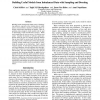Free Online Productivity Tools
i2Speak
i2Symbol
i2OCR
iTex2Img
iWeb2Print
iWeb2Shot
i2Type
iPdf2Split
iPdf2Merge
i2Bopomofo
i2Arabic
i2Style
i2Image
i2PDF
iLatex2Rtf
Sci2ools
FLAIRS
2008
2008
Building Useful Models from Imbalanced Data with Sampling and Boosting
Building useful classification models can be a challenging endeavor, especially when training data is imbalanced. Class imbalance presents a problem when traditional classification algorithms are applied. These algorithms often attempt to build models with the goal of maximizing overall classification accuracy. While such a model may be very accurate, it is often not very useful. Consider the domain of software quality prediction where the goal is to identify program modules that are most likely to contain faults. Since these modules make up only a small fraction of the entire project, a highly accurate model may be generated by classifying all examples as not fault prone. Such a model would be useless. To alleviate the problems associated with class imbalance, several techniques have been proposed. We examine two such techniques: data sampling and boosting. Five data sampling techniques and one commonly used boosting algorithm are applied to five datasets from the software quality pr...
Artificial Intelligence | Class Imbalance | FLAIRS 2008 | Software Quality Prediction | Training Data |
| Added | 02 Oct 2010 |
| Updated | 02 Oct 2010 |
| Type | Conference |
| Year | 2008 |
| Where | FLAIRS |
| Authors | Chris Seiffert, Taghi M. Khoshgoftaar, Jason Van Hulse, Amri Napolitano |
Comments (0)

